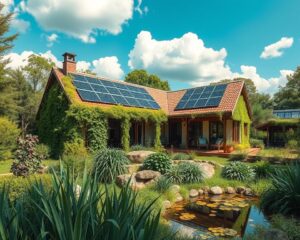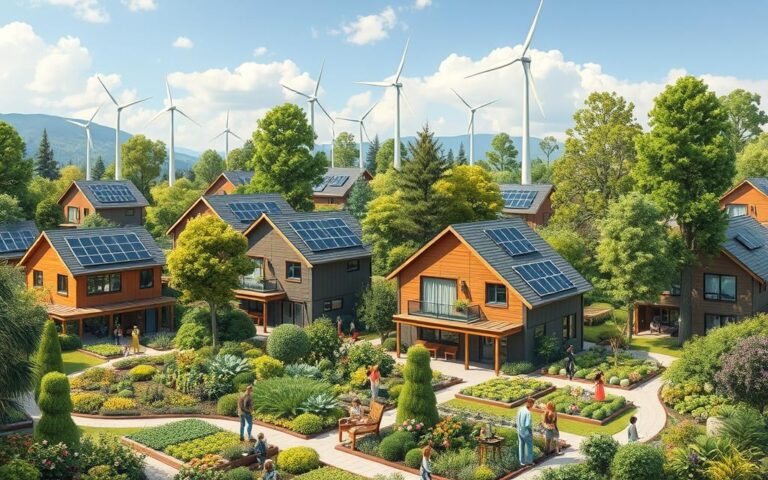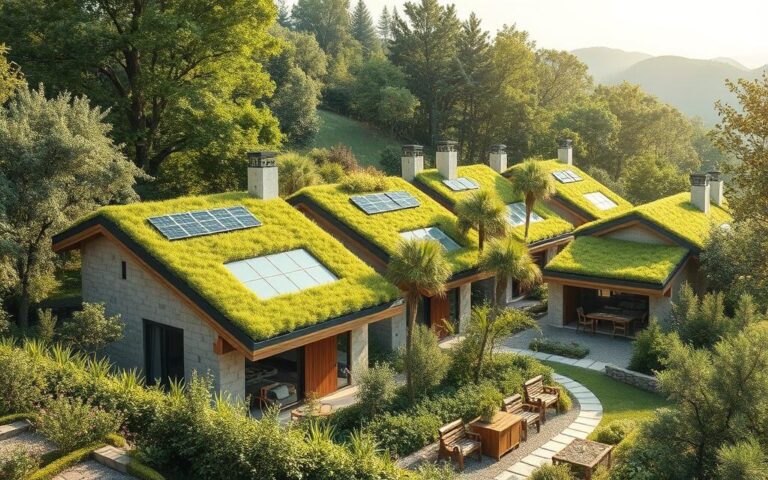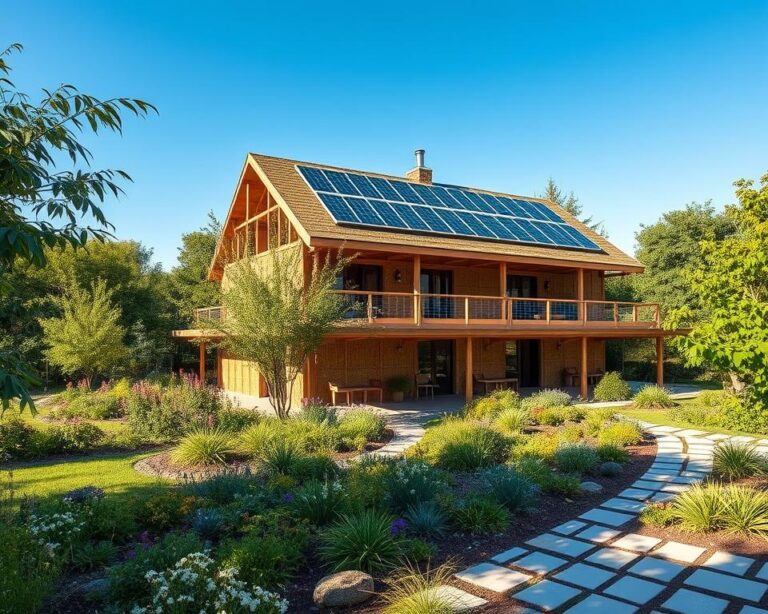Did you know that sustainable buildings can cut energy use by up to 50%? As worries about climate change grow, Low-Impact Living is becoming key. It’s about living in a way that’s good for our planet.
This article shows how you can help cut carbon emissions by designing your home wisely. You can use eco-friendly materials and new techniques. Living in a way that’s kind to the earth makes your home healthier and more lively.
Understanding Low-Impact Living
Living a low-impact lifestyle means making choices that are kind to the planet. By choosing sustainable living, you help the Earth and encourage others to do the same. Let’s dive into what low-impact living is and why it’s important for our planet.
What Does Low-Impact Mean?
A low-impact lifestyle is about using less energy, making less waste, and using fewer resources. It’s about reducing, reusing, and recycling. Simple steps like eating less meat or using energy-saving appliances can make a big difference.
The Importance of Sustainability
Sustainability is key to keeping resources for the future. Knowing how our actions affect the environment helps us make better choices. Supporting eco-friendly businesses helps create a market that values the planet.
Key Principles of Low-Impact Living
The main ideas of low-impact living are:
- Using green technologies to save energy
- Reducing waste through composting and repurposing
- Conserving water with rainwater harvesting and leak fixes
- Using renewable resources to cut down on fossil fuels
- Choosing non-toxic materials for better indoor air
Following these principles makes our homes healthier and more self-sufficient. It also inspires others to live more sustainably, helping to change our culture for the better.
Benefits of Low-Impact Homes
Low-impact homes offer many benefits for your lifestyle and the planet. They help reduce environmental impact and create healthier living spaces. Here are some key advantages of low-impact living.
Environmental Impact Reduction
Low-impact homes are great for saving energy and resources. They use solar panels, efficient insulation, and smart plumbing. This leads to less energy and water use.
Energy-efficient appliances use less power, saving you money on bills. This shows how these homes can greatly reduce environmental impact.
Healthier Living Spaces
Low-impact homes focus on your health. They use non-toxic materials and have better ventilation. This improves indoor air quality.
Using eco-friendly materials reduces harmful emissions. It also makes homeowners feel proud of their contribution to the environment.
Economic Advantages
Low-impact homes are also good for your wallet. They have lower operating costs than traditional homes. For example, they use less energy, which saves on bills.
Studies show green homes sell for more. This makes them a smart investment. You’ll save on bills, maintenance, and see your property value rise.
Choosing Sustainable Materials
When building a low-impact home, the right materials are key. It’s important to know about eco-friendly options and local sources. Choosing wisely makes your home more sustainable and healthier.
Types of Eco-Friendly Materials
There are many eco-friendly materials for building. Here are some top picks:
- Reclaimed Wood: Uses old materials, saving trees and supporting a green cycle.
- Bamboo: Fast-growing and strong, it’s good for the planet.
- Recycled Metal and Glass: Uses old materials, cutting down on new resource use.
Local vs. Non-Local Sourcing
Choosing local materials is a big plus. It cuts down on emissions and helps local businesses. Buying from nearby suppliers is better for the planet and supports your community.
Recycled and Repurposed Options
Using recycled materials is a smart choice. It reduces waste and saves resources. By choosing materials that are reused, you show your commitment to the environment.
| Material Type | Environmental Benefit | Durability | Cost Consideration |
|---|---|---|---|
| Reclaimed Wood | Minimizes deforestation | High | Higher upfront cost, long-term savings |
| Bamboo | Rapidly renewable resource | Medium to High | Affordable, varies by source |
| Recycled Metal | Reduces mining impacts | High | Competitive with new materials |
| Recycled Glass | Less energy for production | Medium | Typically moderate price |
Energy Efficiency in Home Design
Making your home energy-efficient is key to saving money and helping the planet. You can do this by focusing on three main areas: passive solar design, using energy-saving appliances, and improving insulation.
Passive Solar Design
Passive solar design uses the sun’s energy to keep your home cozy. It involves smart window placement and thermal mass to control temperatures. This way, you use less energy for heating and cooling, saving a lot.
Energy-Efficient Appliances
Choosing energy-saving appliances can greatly cut down on energy use. These appliances, marked by the Energy Star program, use less power than regular ones. They help lower your bills and are better for the environment.
Insulation Techniques
Good insulation keeps your home warm in winter and cool in summer. Materials like cellulose and sheep’s wool are eco-friendly options. High R-value insulation materials block heat, reducing the need for heating and cooling. Using advanced framing also helps save wood and improve insulation.
Water Conservation Strategies
Water is getting scarcer, and we’re using more of it. To live sustainably, we need to save water. Using rainwater, low-flow fixtures, and greywater recycling can cut down our daily water use. This helps our planet and saves money on water bills.
Rainwater Harvesting
Rainwater harvesting captures and stores rainwater for different uses. It eases the strain on city water systems. You can install gutters, downspouts, and tanks to store rainwater. Using it for plants or household needs boosts your water-saving efforts. A good system can collect thousands of gallons each year.
Low-Flow Fixtures
Low-flow faucets, showerheads, and toilets save water without losing quality. For instance, a low-flow showerhead can cut water use by up to 60%. This keeps showers enjoyable without wasting water. Ultra-low flush toilets also save water while still flushing well.
Greywater Recycling
Greywater systems collect water from sinks and showers for reuse. This cuts down on fresh water use and wastewater. It can save a family about 20% on water, making it eco-friendly and cost-effective.
| Practice | Water Savings |
|---|---|
| Rainwater Harvesting | Thousands of gallons annually |
| Low-Flow Showerhead | Up to 60% reduction |
| Greywater Recycling | Averaging 20% savings |
| Ultra-Low Flush Toilets | Less than 1.6 gallons per flush |
Landscaping for Low-Impact Living
Creating a sustainable landscape means making smart design choices. These choices help the environment and cut down on upkeep. You can do this by using native plants, organic gardening, and xeriscaping.
Native Plant Landscaping
Native plant landscaping uses plants that do well in your area. These plants need less water and care than others. They also help keep the soil stable and prevent erosion.
Organic Gardening Practices
Organic gardening gets rid of harmful chemicals and makes your soil better. It uses natural fertilizers and composts waste to feed your garden. Mulching keeps the soil moist and weeds away, helping plants grow strong.
Xeriscaping Benefits
Xeriscaping is all about saving water. It uses plants that don’t need much water and smart watering systems. Instead of grass, it often has rock gardens or native plants. This saves water and money on bills.

| Landscaping Feature | Benefits |
|---|---|
| Native Plant Landscaping | Promotes biodiversity, requires less water, helps prevent erosion |
| Organic Gardening | Reduces chemical usage, improves soil health, supports sustainable food sources |
| Xeriscaping | Minimizes water usage, low maintenance, promotes energy efficiency |
Using these ideas in your garden makes it better for the planet. It also makes your outdoor space look great. Choosing low-impact landscaping is a way to care for the earth and enjoy nature.
Indoor Air Quality Considerations
Keeping the air inside your home clean is key to a healthy living space. The materials and ventilation in your home affect the air quality. Using non-toxic materials and natural ventilation can greatly improve your home’s safety and comfort.
Use of Non-Toxic Materials
Choosing non-toxic materials for your home helps keep the air clean. Using low-VOC paints and materials reduces harmful emissions. This makes your home safer for you and your family.
Indoor air pollutants can be harmful, with levels often higher than outside. Using non-toxic materials can lower the risk of health problems like heart disease and cancer.
Natural Ventilation Solutions
Natural ventilation is crucial for clean indoor air. It allows fresh air in and stale air out. Adding windows, vents, and fans helps move air and improves comfort.
These features also save energy. In a world where we spend most of our time indoors, good ventilation is essential. It makes our homes healthier and more productive.
| Indoor Air Pollutants | Sources | Health Effects |
|---|---|---|
| Formaldehyde | Building materials, tobacco smoke | Respiratory issues, eye irritation, cancer risk |
| Radon | Soils, rock, sewage | Lung cancer |
| Mold | Excess moisture, humidity | Allergic reactions, respiratory diseases |
| Nitrogen Dioxide (NO2) | Gas stoves, heating devices | Respiratory problems, increased asthma risk |
| Particulate Matter | Combustion processes, smoke | Cognitive decline, heart disease risk |
By focusing on indoor air quality, you can make your home healthier. Using non-toxic materials and natural ventilation makes your home sustainable and safe.
Implementing Renewable Energy Sources
Using renewable energy is key to reducing our environmental impact and living sustainably. Options like solar, wind, and geothermal heating offer big benefits for our planet and homes. Let’s explore these choices and their advantages.
Solar Energy Options
Solar panels turn sunlight into electricity, reducing our need for fossil fuels and lowering energy costs. The cost of solar energy has fallen a lot in the last decade. Today, a solar PV system can power a big part of your home’s needs.
Wind Power for Residences
Small wind turbines are great for homes to capture wind energy. While costs vary by location, they help cut carbon emissions and make you more self-sufficient.
Benefits of Geothermal Heating
Geothermal systems use the Earth’s temperature for heating and cooling. They’re very efficient, often three times better than traditional systems. With a quick payback period of 10 to 15 years, they’re a smart choice for saving energy.
| Renewable Energy Option | Key Benefits | Cost Overview |
|---|---|---|
| Solar Energy | Reduces electricity bills, decreases fossil fuel dependence | Cost around $3 per watt installed |
| Wind Power | Provides clean energy, lowers carbon footprint | Average installation cost ranges from $10,000 to $70,000 |
| Geothermal Heating | Highly efficient, long-term energy savings | Investment recouped in 10-15 years |
Adding these renewable energy sources to your home moves you toward a greener future. You’ll also enjoy the perks of using clean energy.
Community and Lifestyle Choices
Being part of community sustainability means getting involved in local efforts. These actions help make our environment healthier. By joining in, you improve life for everyone around you.
Engaging in Local Sustainability Efforts
Helping out in local sustainability projects does more than just help. It also motivates others to make eco-friendly choices. Activities like clean-up drives and workshops teach us to care for our planet.
Advocating for Green Spaces
Supporting green spaces is key to a healthier community. These areas are great for fun, help nature, and boost our mood. By pushing for parks and gardens, we create a lively place for outdoor fun.
Building Community Connections
Connecting with people who share your values is important. Working with local groups means sharing knowledge and ideas. This network helps us all live more sustainably.
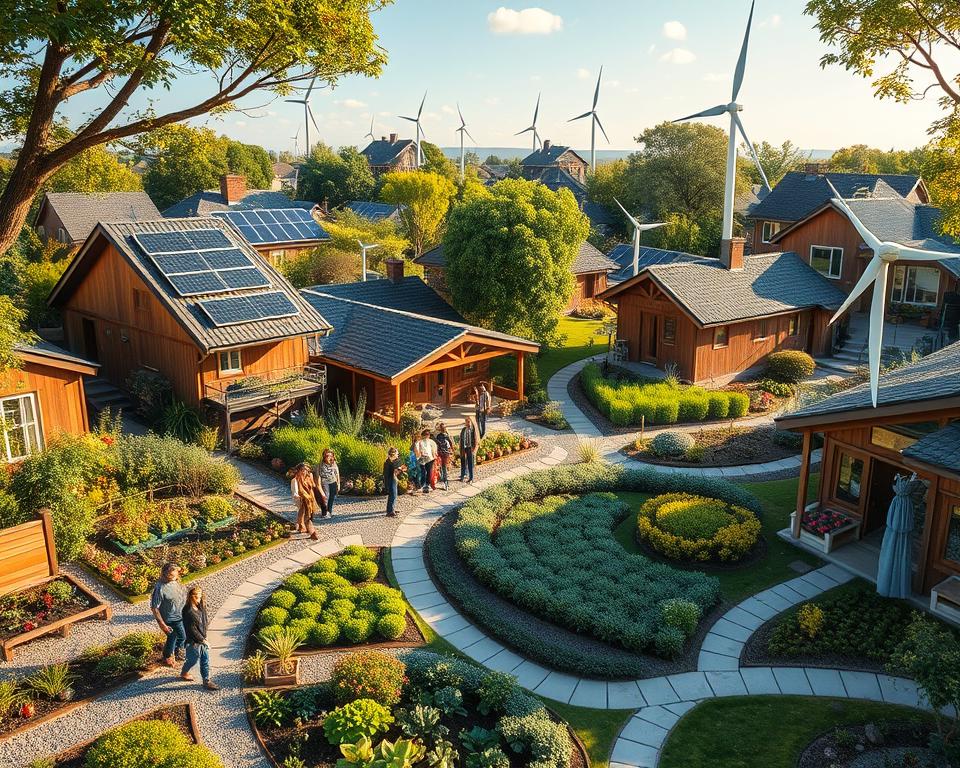
| Initiatives | Benefits | How to Get Involved |
|---|---|---|
| Community Clean-Up Drives | Improves local environments and fosters pride | Join local organizations or create your own event |
| Green Space Development | Enhances well-being and promotes biodiversity | Advocate at town meetings or volunteer for local groups |
| Workshops and Education | Increases awareness and drives eco-conscious choices | Attend or organize workshops in community centers |
Cost-Effective Low-Impact Homes
Making homes affordable is key to living lightly on the earth. You can save money and still live sustainably. DIY projects and grants can help make your home eco-friendly without breaking the bank.
Budgeting for Sustainability
Smart budgeting for sustainability means choosing eco-friendly options that save money in the long run. Homes built to save energy, like prefabs, are cheaper but still high quality. Tiny homes are small but pack a big punch in saving energy and money.
DIY Projects for Eco-Friendly Living
Doing small DIY projects helps you live lightly and saves cash. Building a compost bin or a rain barrel is easy and cheap. These projects help you care for the planet and take charge of your green lifestyle.
Grants and Incentives
Looking into grants and tax credits can make green upgrades more affordable. Many programs offer financial help, just like for solar panels. Using these resources, you can start living more sustainably without financial stress.
Future of Low-Impact Living
The world of sustainable architecture is changing fast. People want homes that are good for the planet. New designs use less energy and waste less, making homes that blend with nature.
Trends in Sustainable Architecture
Looking into sustainable architecture, you’ll see a big push to bring nature inside. Architects add green roofs, natural air flow, and local materials. These changes save resources and make homes more beautiful and useful.
Innovations in Eco-Friendly Technologies
New eco-friendly tech is changing how we live. Smart gadgets use less energy, and solar panels turn sunlight into power. These advancements help us live greener, using less fossil fuels and harming the environment less.
Preparing for a Sustainable Future
Every small step you take helps make the future greener. Simple actions like using less plastic and eating more plants can make a big difference. By being proactive, you help the planet and encourage others to join in.

